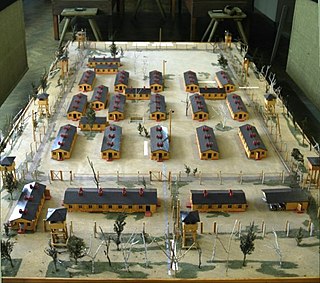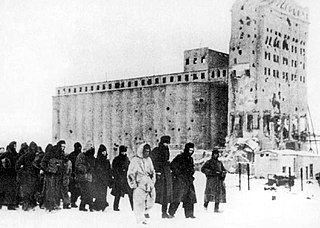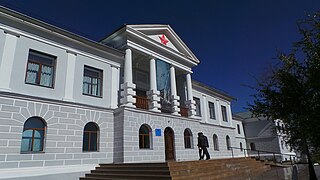
The Gulag was a system of forced labor camps in the Soviet Union. The word Gulag originally referred only to the division of the Soviet secret police that was in charge of running the forced labor camps from the 1930s to the early 1950s during Joseph Stalin's rule, but in English literature the term is popularly used for the system of forced labor throughout the Soviet era. The abbreviation GULAG (ГУЛАГ) stands for "Гла́вное Управле́ние исправи́тельно-трудовы́х ЛАГере́й", but the full official name of the agency changed several times.

A prisoner of war (POW) is a person who is held captive by a belligerent power during or immediately after an armed conflict. The earliest recorded usage of the phrase "prisoner of war" dates back to 1610.

World War II was the deadliest military conflict in history. An estimated total of 70–85 million people perished, or about 3% of the 2.3 billion (est.) people that comprised the global population in 1940. Deaths directly caused by the war are estimated at 50–56 million, with an additional estimated 19–28 million deaths from war-related disease and famine. Civilian deaths totaled 50–55 million. Military deaths from all causes totaled 21–25 million, including deaths in captivity of about 5 million prisoners of war. More than half of the total number of casualties are accounted for by the dead of the Republic of China and of the Soviet Union. The following tables give a detailed country-by-country count of human losses. Statistics on the number of military wounded are included whenever available.
Co-belligerence is the waging of a war in cooperation against a common enemy with or without a military alliance. Generally, the term is used for cases where no formal treaty of alliance exists. Likewise, allies may not become co-belligerents in a war if a casus foederis invoking the alliance has not arisen. Co-belligerents are defined in the Encyclopaedic Dictionary of International Law as "states engaged in a conflict with a common enemy, whether in alliance with each other or not".

The Polish government-in-exile, officially known as the Government of the Republic of Poland in exile, was the government in exile of Poland formed in the aftermath of the Invasion of Poland of September 1939, and the subsequent occupation of Poland by Germany, the Soviet Union, and the Slovak Republic, which brought to an end the Second Polish Republic.

Hiwi, the German abbreviation of the word Hilfswilliger or, in English, auxiliary volunteer, designated, during World War II, a member of different kinds of voluntary auxiliary forces made up of recruits indigenous to the territories of Eastern Europe occupied by Nazi Germany. Adolf Hitler reluctantly agreed to allow recruitment of Soviet citizens in the Rear Areas during Operation Barbarossa. In a short period of time, many of them were moved to combat units.
Southern Front may refer to:

In Germany, stalag was a term used for prisoner-of-war camps. Stalag is a contraction of "Stammlager", itself short for Kriegsgefangenen-Mannschaftsstammlager, literally "main camp for enlisted prisoners of war". Therefore, "stalag" technically means "main camp".

Anti-Sovietism or anti-Soviet sentiment refers to persons and activities that were actually or allegedly aimed against the Soviet Union or government power within the Soviet Union.
During World War II, the Allies committed legally proven war crimes and violations of the laws of war against either civilians or military personnel of the Axis powers. At the end of World War II, many trials of Axis war criminals took place, most famously the Nuremberg Trials and Tokyo Trials. In Europe, these tribunals were set up under the authority of the London Charter, which only considered allegations of war crimes committed by people who acted in the interests of the Axis powers. Some war crimes involving Allied personnel were investigated by the Allied powers and led in some instances to courts-martial. Some incidents alleged by historians to have been crimes under the law of war in operation at the time were, for a variety of reasons, not investigated by the Allied powers during the war, or were investigated but not prosecuted.

Italian prisoners of war in the Soviet Union is the narrative of POWs from the Italian Army in Russia and of their fate in Stalin's Soviet Union during and after World War II.

The war crimes and crimes against humanity which were perpetrated by the Soviet Union and its armed forces from 1919 to 1991 include acts which were committed by the Red Army as well as acts which were committed by the country's secret police, NKVD, including its Internal Troops. In many cases, these acts were committed upon the orders of the Soviet leaders Vladimir Lenin and Joseph Stalin in pursuance of the early Soviet government's policy of Red Terror. In other instances they were committed without orders by Soviet troops against prisoners of war or civilians of countries that had been in armed conflict with the USSR, or they were committed during partisan warfare.
Red Orchestra may refer to:

German-occupied Europe refers to the sovereign countries of Europe which were wholly or partly militarily occupied and civil-occupied, including puppet governments, by the military forces and the government of Nazi Germany at various times between 1939 and 1945, during World War II, administered by the Nazi regime under the dictatorship of Adolf Hitler.

By the end of World War II, the number of Romanian prisoners of war in the Soviet Union was significant. Up to 100,000 Romanian soldiers were disarmed and taken prisoner by the Red Army after the Royal coup d'état of August 23, 1944, when Romania switched its alliance from the Axis Powers to the Allies. Before that date, almost 165,000 Romanian soldiers were reported missing, with most of them assumed to be POWs. Soviet authorities generally used prisoners of war as a work force in various labor camps.

Soviet prisoners of war (POWs) held by Nazi Germany and primarily in the custody of the German Army, were starved and subjected to deadly conditions. Of nearly six million that were captured, around 3 million died during their imprisonment.
There were two waves of the Finnish prisoners of war in the Soviet Union during World War II: POWs during the Winter War and the Continuation War.

After the Munich Agreement, the Soviet Union pursued a rapprochement with Nazi Germany. On 23 August 1939 the Soviet Union signed a non-aggression pact with Germany which included a secret protocol that divided Eastern Europe into German and Soviet "spheres of influence", anticipating potential "territorial and political rearrangements" of these countries. Germany invaded Poland on 1 September 1939, starting World War II. The Soviets invaded eastern Poland on 17 September. Following the Winter War with Finland, the Soviets were ceded territories by Finland. This was followed by annexations of the Baltic states and parts of Romania.

During World War II, it was estimated that between 35,000 and 50,000 members of the Imperial Japanese Armed Forces surrendered to Allied servicemembers prior to the end of World War II in Asia in August 1945. Also, Soviet troops seized and imprisoned more than half a million Japanese troops and civilians in China and other places. The number of Japanese soldiers, sailors, marines, and airmen who surrendered was limited by the Japanese military indoctrinating its personnel to fight to the death, Allied combat personnel often being unwilling to take prisoners, and many Japanese soldiers believing that those who surrendered would be killed by their captors.

Soviet prisoners of war in Finland during World War II were captured in two Soviet-Finnish conflicts of that period: the Winter War and the Continuation War. The Finns took about 5,700 POWs during the Winter War, and due to the short length of the war they survived relatively well. However, during the Continuation War the Finns took 64,000 POWs, of whom almost 30 percent died.














